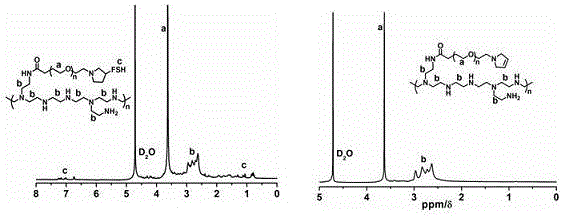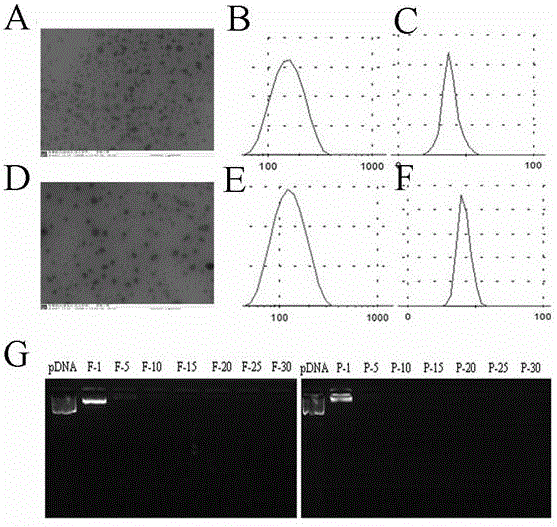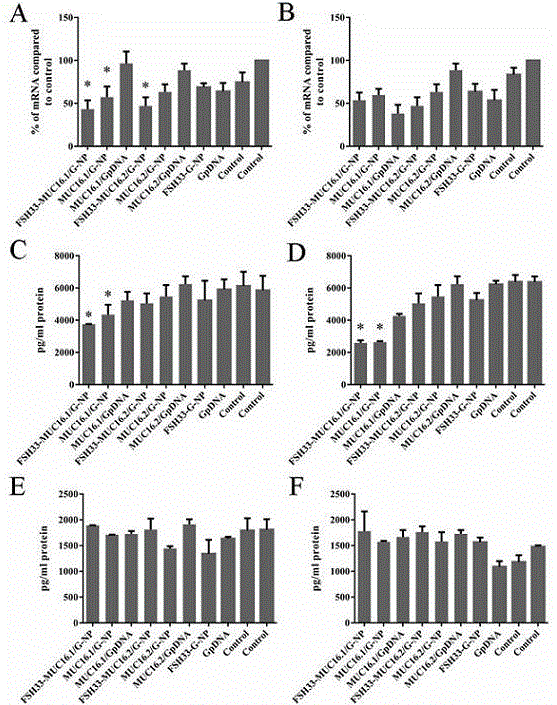Targeted drug delivery system modified by follicle-stimulating hormone polypeptide and regulated by promoter MUC16 and preparation method of targeted drug delivery system
A follicle-stimulating hormone and drug delivery system technology, which is applied in the field of in vivo and in vitro curative effect investigation of the targeting system, can solve the problems of recurrence or drug resistance, treatment failure and other problems of advanced patients, and achieve reduction of non-specific uptake, minimization of toxic and side effects, The effect of increasing specific uptake
- Summary
- Abstract
- Description
- Claims
- Application Information
AI Technical Summary
Problems solved by technology
Method used
Image
Examples
Embodiment 1
[0046] targeted detection
[0047] Ovarian cancer cells HEY and SKOV3 were cultured in vitro, and nanocomplexes regulated by FSH polypeptide modification and / or MUC16 promoter (FSH33- Silencing effect of G-NP, FSH33-MUC16.1 / G-NP and FSH33-MUC16.2 / G-NP) on the target gene gro-α ( image 3 , Figure 4 ). The results showed that in FSHR-positive MUC16-positive HEY cells, the down-regulation effect of FSH33-MUC16.1 / G-NP and FSH-MUC16.2 / G-NP on gro-α mRNA was higher than that of other groups, and the gro in the supernatant The level of -α was significantly lower than that of other groups, and the difference was statistically significant. After 48 hours of transfection, FSH33-MUC16.1 / G-NP can significantly reduce the level of gro-α protein in the cytoplasm. In FSHR-negative MUC16-positive SKOV3 cells, after FSH33-MUC16.1 / G-NP transfection for the same time, the down-regulation effect of gro-α mRNA, the level of gro-α in supernatant and the level of gro in cytoplasmic protein amo...
Embodiment 2
[0049] Evaluation of the Effects of Nanocomplexes on the Malignant Biological Behavior of Ovarian Cancer Cells
[0050] The specific steps of the cytotoxicity test were operated according to the instructions of the CCK8 kit. Figure 5 The proliferation activity of HEY and SKOV3 cells was shown at 24h, 48h, 72h and 96h after treatment with different groups of nanocomposites. In FSHR-positive and MUC16-positive ovarian cancer HEY cells, the proliferative activity of cells was differently inhibited after FSH33-MUC16.1 / G-NP, FSH33-MUC16.2 / G-NP and FSH33-G-NP nanocomplexes. Among them, the inhibitory effect of FSH33-MUC16.1 / G-NP is the most obvious, and the cell activity after 96 hours of treatment is only 25.32% of that of the control group, and the difference is statistically significant compared with other groups. In the FSHR-negative and MUC16-positive ovarian cancer SKOV3 cells, the cell viability was not significantly inhibited after transfection with the drugs of each group...
Embodiment 3
[0053] Preliminary evaluation of in vivo pharmacodynamics and safety of targeted nanocomplexes
[0054] Replicate human ovarian cancer subcutaneous xenograft tumor model, divided into 6 groups: targeting complex modified by FSH polypeptide and regulated by MUC16.1 promoter (5% FSH33-MUC16.1 / G-NP); nanocomposite modified by FSH polypeptide Object group (5%FSH33-G-NP), nanocomplex barrier without FSH polypeptide modification (MUC16.1 / G-NP); naked plasmid group (pDNA); blank nanoparticle group (NP), solvent control group ( Control).
PUM
| Property | Measurement | Unit |
|---|---|---|
| molecular weight | aaaaa | aaaaa |
| molecular weight | aaaaa | aaaaa |
Abstract
Description
Claims
Application Information
 Login to View More
Login to View More - R&D
- Intellectual Property
- Life Sciences
- Materials
- Tech Scout
- Unparalleled Data Quality
- Higher Quality Content
- 60% Fewer Hallucinations
Browse by: Latest US Patents, China's latest patents, Technical Efficacy Thesaurus, Application Domain, Technology Topic, Popular Technical Reports.
© 2025 PatSnap. All rights reserved.Legal|Privacy policy|Modern Slavery Act Transparency Statement|Sitemap|About US| Contact US: help@patsnap.com



